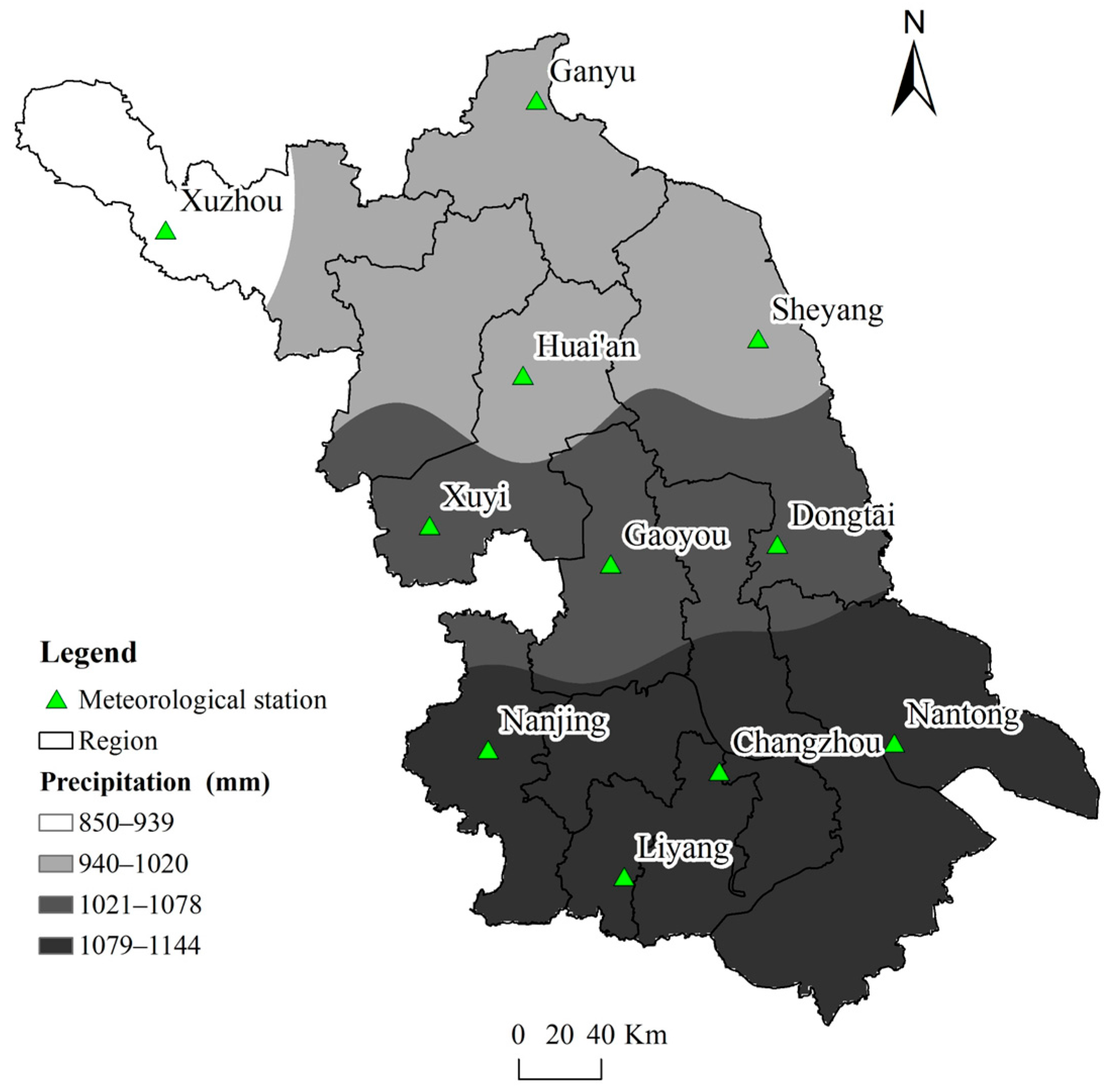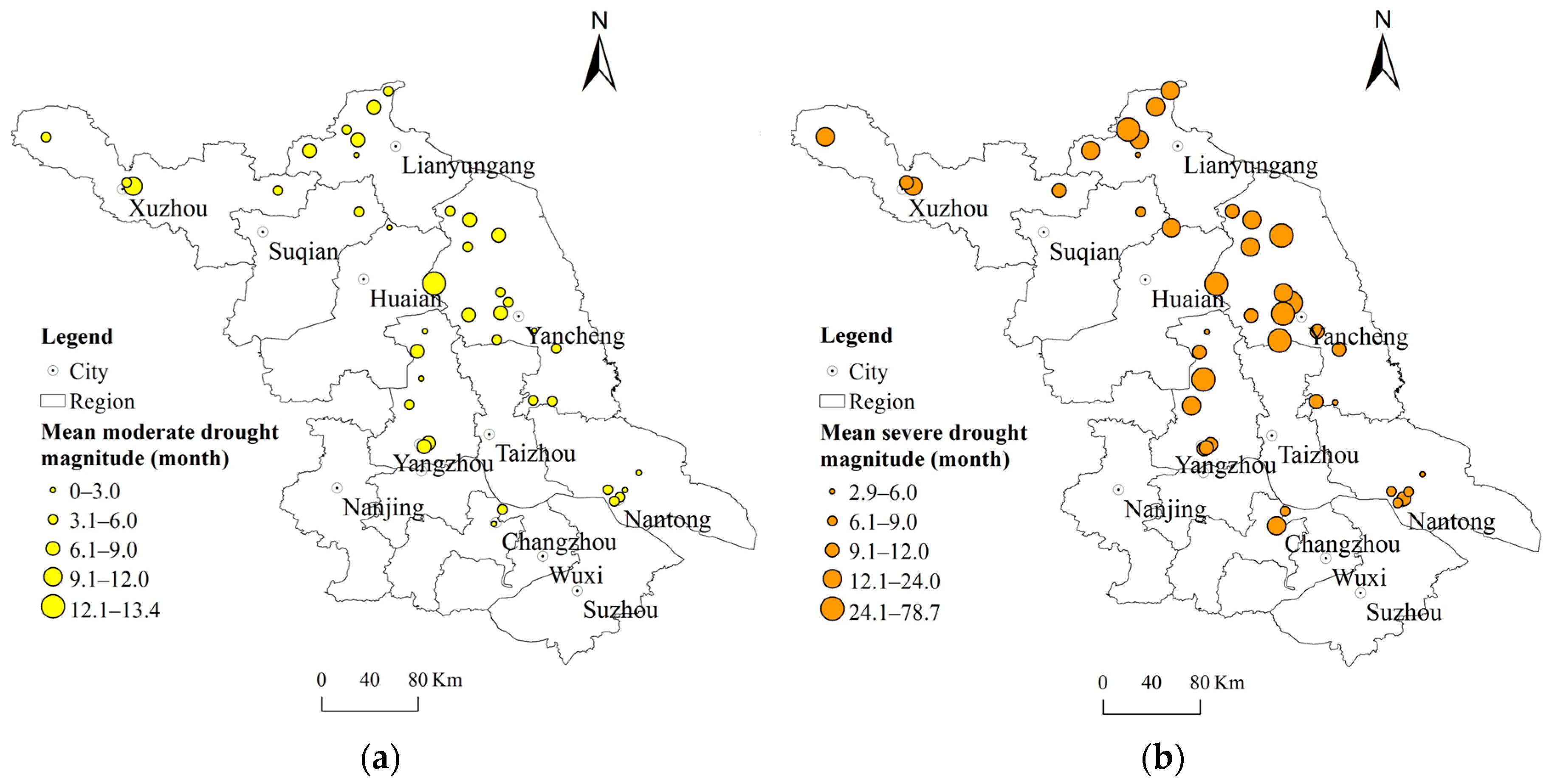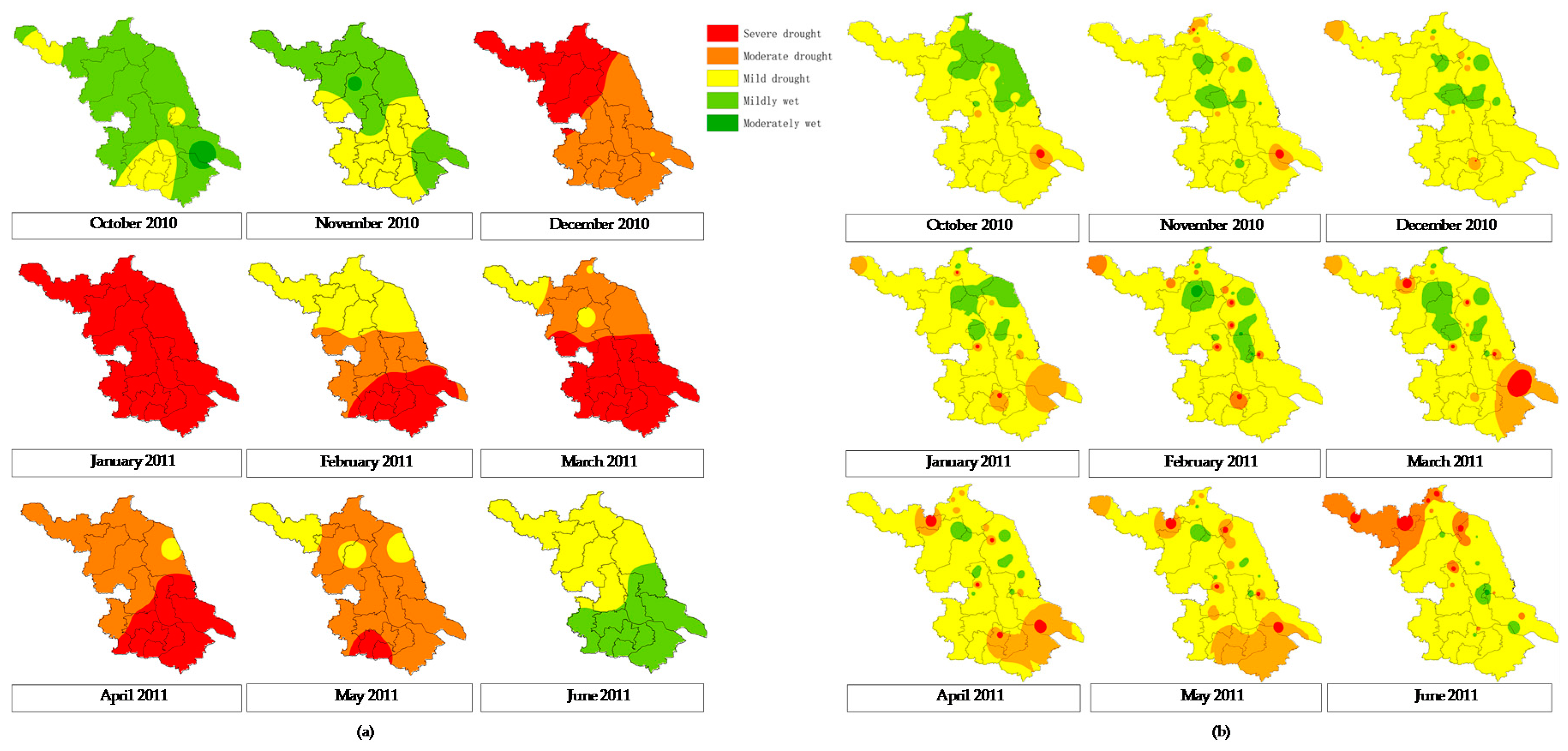Spatiotemporal Characteristics of Groundwater Drought and Its Response to Meteorological Drought in Jiangsu Province, China
Abstract
:1. Introduction
2. Study Area and Data
3. Method
3.1. Drought Indices
3.1.1. Standardized Precipitation Index
3.1.2. Standardized Groundwater Level Index
3.2. Drought Identification and Characteristics
3.3. Variance Correction Pre-Whitening Mann–Kendall Test
4. Results
4.1. Overview of Droughts
4.2. Groundwater Drought Characteristics
4.2.1. Statistic Trend Analyses of Groundwater Drought
4.2.2. Frequency of Drought
4.2.3. Mean Duration of Drought
4.2.4. Mean Magnitude of Drought
4.3. Regional Characteristics of Groundwater Drought and Meteorological Drought
5. Discussion
6. Conclusions
- Although the mean SPI and SGI for the entire region showed good correlation, there were clear discrepancies between the SGI and SPI. This reveals a mitigation process from meteorological droughts to groundwater droughts; therefore, there is a need to consider different variables in order to completely characterize droughts.
- Groundwater drought showed different regional characteristics in this study area. Statistically significant negative trends of SGI index towards dryer conditions were mainly found in the NW and central regions, whereas positive trends of SGI towards wetter conditions were mainly found in the NE region; the southern region showed a nonsignificant dryer trend.
- The frequency of severe drought had a similar distribution to that of moderate drought, with the southern and central regions showing higher frequency than the NW and NE regions. The spatial distributions of mean moderate and severe drought durations showed contrasting patterns to those of mean moderate and severe drought frequencies. The central and southern regions experienced shorter mean moderate drought durations than the NW and NE regions; as for mean severe drought, the southern region showed shorter duration than the rest of the study area. In addition, the spatial distributions of mean moderate and severe drought magnitude were similar to those of mean moderate and severe drought duration. The southern region exhibited lower mean magnitude for moderate drought than the NW and NE regions; as for mean severe drought magnitude, the southern region showed a lower mean magnitude than the rest of the study area.
- Different regions showed differences in terms of the response of groundwater drought to meteorological drought. Specifically, the NE and NW regions showed weaker correlations between groundwater drought and meteorological drought compared with the southern and central regions.
- Jiangsu Province experienced more frequent meteorological drought than groundwater drought for both moderate and severe droughts during the study period, while the mean duration and mean magnitude of groundwater drought were longer than those of corresponding regional meteorological drought. In addition, there was a strong relationship between mean drought duration and magnitude for moderate drought, whereby longer episodes of meteorological and groundwater drought were associated with droughts of greater magnitude. However, there was no such regular relationship for severe drought in the study area.
Supplementary Materials
Acknowledgments
Author Contributions
Conflicts of Interest
References
- Wilhite, D.A. Drought as a Natural Hazard: Concepts and Definitions. In Drought: A Global Assessmen; Donald, A.W., Ed.; Routledge: London, UK, 2000; Volume 1, pp. 3–18. [Google Scholar]
- Wilhite, D.A.; Glantz, M.H. Understanding: The Drought Phenomenon: The Role of Definitions. Water Int. 1985, 10, 111–120. [Google Scholar] [CrossRef]
- Van Lanen, H.A.J.; Peters, E. Definition, Effects and Assessment of Groundwater Droughts. In Drought and Drought Mitigation in Europe; Springer: Dordrecht, The Netherlands, 2000; Volume 14, pp. 49–61. [Google Scholar]
- Hisdal, H.; Clausen, B.; Gustard, A.; Peters, E.; Tallaksen, L.M. Event Definitions and Indices. In Hydrological Drought—Processes and Estimation Methods for Streamflow and Groundwater; Tallaksen, L.M., van Lanen, H.A.J., Eds.; Elsevier Science B.V.: Amsterdam, The Netherlands, 2004; Volume 48, pp. 139–198. [Google Scholar]
- Mishra, A.K.; Singh, V.P. A Review of Drought Concepts. J. Hydrol. 2010, 391, 202–216. [Google Scholar] [CrossRef]
- Eltahir, E.A.B.; Yeh, P.J.F. On the Asymmetric Response of Aquifer Water Level to Floods and Droughts in Illinois. Water Resour. Res. 1999, 35, 1199–1217. [Google Scholar] [CrossRef]
- Peters, E.; Torfs, P.J.J.F.; van Lanen, H.A.J.; Bier, G. Propagation of Drought through Groundwater—A New Approach Using Linear Reservoir Theory. Hydrol. Process. 2003, 17, 3023–3040. [Google Scholar] [CrossRef]
- Peters, E.; Bier, G.; van Lanen, H.A.J.; Torfs, P.J.J.F. Propagation and Spatial Distribution of Drought in a Groundwater Catchment. J. Hydrol. 2006, 321, 257–275. [Google Scholar] [CrossRef]
- Tallaksen, L.M.; Hisdal, H.; Lanen, H.A.J. Van. Space–time Modelling of Catchment Scale Drought Characteristics. J. Hydrol. 2009, 375, 363–372. [Google Scholar] [CrossRef]
- Bhuiyan, C.; Singh, R.P.; Kogan, F.N. Monitoring Drought Dynamics in the Aravalli Region (India) Using Different Indices Based on Ground and Remote Sensing Data. Int. J. Appl. Earth Obs. Geoinf. 2006, 8, 289–302. [Google Scholar] [CrossRef]
- Mendicino, G.; Senatore, A.; Versace, P. A Groundwater Resource Index (GRI) for Drought Monitoring and Forecasting in a Mediterranean Climate. J. Hydrol. 2008, 357, 282–302. [Google Scholar] [CrossRef]
- Bloomfield, J.P.; Marchant, B.P. Analysis of Groundwater Drought Building on the Standardised Precipitation Index Approach. Hydrol. Earth Syst. Sci. 2013, 17, 4769–4787. [Google Scholar] [CrossRef] [Green Version]
- Li, B.; Rodell, M. Evaluation of a Model-Based Groundwater Drought Indicator in the Conterminous U.S. J. Hydrol. 2015, 526, 78–88. [Google Scholar] [CrossRef]
- Wilhite, D.A.; Hayes, M.J.; Svoboda, M.D. Drought Monitoring and Assessment: Status and Trends in the United States. In Advances in Natural and Technological Hazards; Vogt, J.V., Somma, F., Eds.; Springer: Dordrecht, The Netherlands, 2000; pp. 149–160. [Google Scholar]
- Bao, Y.X.; Meng, C.L.; Shen, S.H.; Qiu, X.F.; Gao, P.; Liu, C. Temporal and Spatial Patterns of Droughts for Recent 50 Years in Jiangsu Based on Meteorological Drought Composite Index. Acta Geogr. Sin. 2011, 66, 599–608. [Google Scholar]
- Zhang, P.B.; Jiang, Y.S.; Liu, L.; Li, Y.; Hu, S.S. Comparative Analysis of Sustained Drought Processes in Jiangsu during 1971–2011. Plateau Meteorol. 2015, 34, 444–454. [Google Scholar]
- Shi, X.; Jiang, F.; Feng, Z.; Yao, B.; Xu, H.; Wu, J. Characterization of the Regional Groundwater Quality Evolution in the North Plain of Jiangsu Province, China. Environ. Earth Sci. 2015, 74, 5587–5604. [Google Scholar] [CrossRef]
- McKee, T.B.; Doesken, N.J.; Kleist, J. The Relationship of Drought Frequency and Duration to Time Scales. In Proceedings of the 8th Conference on Applied Climatology; American Meteorological Society: Boston, MA, USA, 1993; pp. 179–184. [Google Scholar]
- Hayes, M.; Svoboda, M.; Wall, N.; Widhalm, M. The Lincoln Declaration on Drought Indices: Universal Meteorological Drought Index Recommended. Bull. Am. Meteorol. Soc. 2011, 92, 485–488. [Google Scholar] [CrossRef]
- Vicente-Serrano, S.M. Differences in Spatial Patterns of Drought on Different Time Scales: An Analysis of the Iberian Peninsula. Water Resour. Manag. 2006, 20, 37–60. [Google Scholar] [CrossRef]
- Guttman, N.B. Accepting the Standardized Precipitation Index: A Calculation Algorithm1. J. Am. Water Resour. Assoc. 1999, 35, 311–322. [Google Scholar] [CrossRef]
- Sheffield, J.; Goteti, G.; Wen, F.; Wood, E.F. A Simulated Soil Moisture Based Drought Analysis for the United States. J. Geophys. Res. D Atmos. 2004, 109, 1–19. [Google Scholar] [CrossRef]
- Vidal, J.-P.; Martin, E.; Franchistéguy, L.; Habets, F.; Soubeyroux, J.-M.; Blanchard, M.; Baillon, M. Multilevel and Multiscale Drought Reanalysis over France with the Safran-Isba-Modcou Hydrometeorological Suite. Hydrol. Earth Syst. Sci. Discuss. 2009, 6, 6455–6501. [Google Scholar] [CrossRef]
- Shukla, S.; Wood, A.W. Use of a Standardized Runoff Index for Characterizing Hydrologic Drought. Geophys. Res. Lett. 2008, 35, 1–7. [Google Scholar] [CrossRef]
- Vicente-Serrano, S.M.; López-Moreno, J.I.; Beguería, S.; Lorenzo-Lacruz, J.; Azorin-Molina, C.; Morán-Tejeda, E. Accurate Computation of a Streamflow Drought Index. J. Hydrol. Eng. 2012, 17, 318–332. [Google Scholar] [CrossRef] [Green Version]
- Wang, W.; Chen, Y.; Becker, S.; Liu, B. Variance Correction Prewhitening Method for Trend Detection in Autocorrelated Data. J. Hydrol. Eng. 2009, 20, 1–10. [Google Scholar] [CrossRef]
- Hamed, K.H. Enhancing the Effectiveness of Prewhitening in Trend Analysis of Hydrologic Data. J. Hydrol. 2009, 368, 143–155. [Google Scholar] [CrossRef]
- Helsel, D.R.; Hirsch, R.M. Statistical Methods in Water Resources; Elsevier: Amsterdam, The Netherland, 1992; p. 522. [Google Scholar]
- Van Loon, A.F. Hydrological drought explained. Wiley Interdiscip. Rev. Water 2015, 2, 359–392. [Google Scholar] [CrossRef]
- Wu, H.; Hayes, M.J.; Wilhite, D.A.; Svoboda, M.D. The effect of the length of record on the standardized precipitation index calculation. Int. J. Climatol. 2005, 25, 505–520. [Google Scholar] [CrossRef]












| Region | Mean Annual Precipitation (mm) | Average Elevation (m) | Mean Annual Groundwater Depth (m) | Number of Precipitation Stations | Number of Groundwater Observation Wells |
|---|---|---|---|---|---|
| Northwest | 850 | 30–50 | 2–3 | 1 | 4 |
| Northeast | 950 | 3–20 | 1–2 | 3 | 15 |
| Central | 1050 | 2–10 | 0.4–1.5 | 3 | 14 |
| South | 1100 | 3–10 | 1–4.5 | 4 | 7 |
| Index Value | Class |
|---|---|
| Extremely wet | |
| Severely wet | |
| Moderately wet | |
| Near normal | |
| Moderate drought | |
| Severe drought | |
| Extreme drought |
| Region | Drought Index | VCPW MK | Number of Drought Events | Mean Drought Duration | Mean Drought Magnitude |
|---|---|---|---|---|---|
| Northwest | SPI-5 | −1.40 | 6(6) | 10.2 (7.2) | 6.9 (8.1) |
| SGI-1 | −5.68 * | 3(1) | 9.7 (39) | 10.7 (28.8) | |
| Northeast | SPI-6 | −0.22 | 10(1) | 7.7 (14) | 5.5 (15.7) |
| SGI-1 | 2.33 * | 0(0) | 0 (0) | 0 (0) | |
| Central | SPI-2 | −1.35 | 10(10) | 3.3 (5.8) | 2.4 (5.1) |
| SGI-1 | −1.00 | 0(0) | 0 (0) | 0 (0) | |
| South | SPI-2 | −0.98 | 18(5) | 3.4 (5.6) | 2.6 (5.7) |
| SGI-1 | −0.87 | 4(0) | 9.5 (0) | 5.7 (0) |
© 2016 by the authors; licensee MDPI, Basel, Switzerland. This article is an open access article distributed under the terms and conditions of the Creative Commons Attribution (CC-BY) license (http://creativecommons.org/licenses/by/4.0/).
Share and Cite
Liu, B.; Zhou, X.; Li, W.; Lu, C.; Shu, L. Spatiotemporal Characteristics of Groundwater Drought and Its Response to Meteorological Drought in Jiangsu Province, China. Water 2016, 8, 480. https://doi.org/10.3390/w8110480
Liu B, Zhou X, Li W, Lu C, Shu L. Spatiotemporal Characteristics of Groundwater Drought and Its Response to Meteorological Drought in Jiangsu Province, China. Water. 2016; 8(11):480. https://doi.org/10.3390/w8110480
Chicago/Turabian StyleLiu, Bo, Xiangqian Zhou, Wei Li, Chengpeng Lu, and Longcang Shu. 2016. "Spatiotemporal Characteristics of Groundwater Drought and Its Response to Meteorological Drought in Jiangsu Province, China" Water 8, no. 11: 480. https://doi.org/10.3390/w8110480






